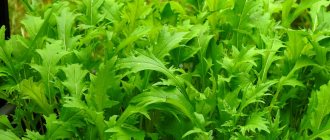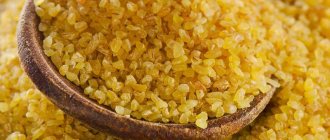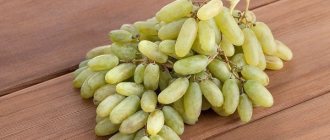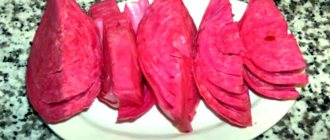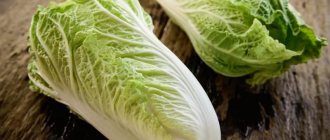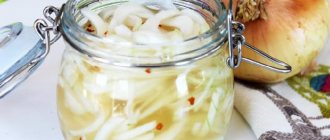Salad with bacon and cabbage
A hearty salad of savoy cabbage with bacon, which can be replaced with smoked sausage or chicken if you want to reduce the calorie content of the dish.
Compound:
- Savoy cabbage – 550 gr.
- Bacon (smoked) – 250 gr.
- Olive oil - spoon.
- Garlic cloves – 2 pcs.
- Lemon juice - a small spoon.
- Egg.
Preparation:
- Chop the head of cabbage into thin strips and scald with boiling water. After a minute, drain the liquid and squeeze out.
- Cut the bacon (sausage) into slices. Fry in oil in a frying pan. Place the bacon in a salad bowl and fry the chopped garlic in this oil.
- The day before, boil the egg and chop it into cubes.
- Combine all the ingredients in a salad bowl, pour in the oil remaining in the pan after frying. Stir the salad and invite your household members to the table.
Selection and preparation of heads of cabbage
To get a tasty and crispy snack that will not spoil during the winter, it is important to choose the right heads of cabbage:
Late varieties are best suited for pickling. They have coarser leaves, which become more tender, but do not soften when harvested and are stored longer. It is better to choose heads of cabbage weighing at least 0.5 kg
Regardless of their size, the stalks will be approximately the same, so it is more profitable to take large specimens. The heads of cabbage should not be frozen, otherwise they will not be stored for long. It is important that the top leaves are on the cabbage. If they are not there, most likely they were cut off because they were frozen or infected. The vegetable should not have rotten, dark spots, damage or signs of disease.
This negatively affects the shelf life and taste of the finished product. There should be no holes on the leaves. They indicate the presence of caterpillars inside the head of cabbage. Dirt between the leaves indicates non-compliance with harvesting technology, which will negatively affect the shelf life of the product.
To prepare Savoy cabbage for pickling, wash it well under running water, peel it from the top leaves, and remove the stalk.
Selection of containers
It is convenient to pickle food for the winter in a large container. Typically, enamel pots and buckets, wooden barrels and tubs, glass trays and jars are used.
It is better to store salad in small containers with lids.
Additional Ingredients
Regular rock salt is suitable for salting. Its iodized analog helps soften the cabbage. Fine “Extra” salt is also added, but with it it is easy to over-salt the dish.
Herbs and spices go well with vegetables: currant, cherry, horseradish leaves, dill umbrellas, black and allspice peas.
Sometimes other vegetables are used. There are recipes with bell and hot peppers, celery, and carrots.
Where does Savoy cabbage come from and what's special about it?
This type of cabbage is native to northern Italy, where it has been cultivated for more than 500 years. It owes its name to one of the northern Italian duchies, which disappeared from the map of Europe at the beginning of the 18th century. In Italy itself it is usually called Milanese or Lombard, and in the Czechs – French.
Savoy cabbage
Externally, its forks are quite similar to white cabbage, but are looser due to the highly corrugated leaves. The undeniable advantage of Savoy cabbage is its delicate taste, which is superior in quality to the taste of its white relative. Europeans, as well as residents of the USA and Canada, actively use it to create a variety of dishes.
From an agrotechnical point of view, Savoy cabbage is more resistant to weather changes and diseases, can withstand droughts and frosts down to -8° C, but is less productive than white cabbage and is stored worse - only 1-2 months. It is cultivated through seedlings and is no different in care from cabbage cabbage. The yield level is up to 8 kg per 1 m².
Is it possible to pickle Savoy cabbage for the winter and what are the ways to store it | My kitchen
Savoy cabbage has no equal among the entire family of these vegetables when it comes to juiciness, tenderness and benefits. Even thin-leaved Chinese cabbage loses to a simple white cabbage, compared to Italian cabbage. Growing Savoy cabbage is not as easy as the usual varieties, the main thing is that the weather permits. But you will have to take extra care to ensure the safety of this storehouse of vitamins.
How to preserve savoy cabbage for the winter at home
The general principles of storage differ little from the conditions designed for white cabbage. Let us immediately make a reservation that our article is not intended for the attention of farmers who grow significant crops and prepare vegetables for sale.
But if you purchased a certain amount of cabbage at the autumn fair or grew it in your garden plot, a story on how to store Savoy cabbage at home will be useful to you.
The vegetable is not only healthier than its relatives, but also noticeably more tender. If white cabbage suffers little from low temperatures and is stored relatively well at them, then Savoy cabbage has to create more stable conditions. Savoy cabbage will survive winter storage relatively painlessly if the room temperature ranges from zero to +4 degrees.
Suitable for storing cellars and pantries with a humidity of about 90%, with sufficient air flow. This type of cabbage is most often stored in nets or in bulk, collected in small pyramids.
Of course, there must be protection from the cold emanating from the floor of the room. Before storing Savoy cabbage, the room is thoroughly cleaned, treated for pests and ventilated. Then a boardwalk is made on the floor, and cabbage is laid on it.
It is important to comply with the following conditions:
- The heads of cabbage must be completely ripe and show no signs of damage.
- Before storing Savoy cabbage for the winter, turn it over so that the stalk is facing up.
- If the cabbage is stacked in a pile, the larger heads of cabbage are located at the bottom.
NOTE!
According to experience, larger cabbage forks last longer. For this reason, they should be laid down the pyramid.
How to pickle savoy cabbage
Traditional methods of winter storage of vegetables, including cabbage, include partial processing. White cabbage pickles are in high demand, but what can you make from Savoy cabbage?
You will need:
- a large head of savoy cabbage;
- three bell peppers and the same number of hot peppercorns;
- coarse salt;
- water;
- ground coriander;
- a pair of medium-sized garlic heads.
Pickling Savoy cabbage for the winter, how to prepare it:
- We rinse the selected fork and get rid of the outer leaves. As is the case with all other varieties of cabbage, they are often rough and dry.
- We cut the fork in half, cutting the stalk as well. Next, cut each part into three large pieces.
- Using two liters of water and 4 heaping tablespoons of salt, prepare and strain the brine and pour it over the cabbage in a saucepan or bucket. Be sure to place a weight of one and a half kilograms on top, placing a regular flat plate under it.
- We prepare the sauce from peppers, for which we remove the tails from all the fruits, and also the seeds from the sweet. Peel the garlic and grind it together with the pepper in a blender, add coriander for a lasting aroma and add salt.
NOTE!
The sauce must be very salty, otherwise the product will spoil. Keep this in mind, but still be moderate! We prepare it on the day of pickling the cabbage, then keep it in an airtight jar in the cold.
- On the third day, remove the cabbage from the brine. Gently bending back the leaves, generously apply the sauce to them. If desired, you can separate the leaves from the stalk. We put it again in the same container in which the salting took place and fill it with the same brine.
- Be careful, the amount of brine should be such that the liquid completely covers the leaves, but no more. Put it back in place and bend it. Leave the cabbage leaves for up to two more days, then transfer them to a glass container and refrigerate.
The cabbage is tasty, but due to the peculiarities of the recipe, it is salty. If it will be stored in winter on the balcony or in another place at sub-zero temperatures, serve the appetizer that way. It’s especially good with fried potatoes; brown them and serve hot, and the frost-crisp, spicy savoy cabbage doesn’t even need to be chopped.
Step-by-step recipe for preparing savoy cabbage preparations for the winter
Among various recipes for preparing preparations for the winter, Savoy cabbage has begun to gain popularity. This is a healthy vegetable that came to our country from the Italian county of Savoie. Its heads are easy to distinguish from other varieties, as the leaves are strongly corrugated. Cabbage is tender in taste and contains a huge amount of useful substances. Therefore, it is useful to prepare preparations with Savoy cabbage for the winter, when we are so lacking in vitamins.
Features of preparing Savoy cabbage for the winter
To ensure that savoy cabbage preparations remain crispy and tasty, you should adhere to the following recommendations:
- When cooking, do not use aluminum cookware - the vegetable may change color during cooking. For these purposes, you should take enamel pans.
- To ensure that the cabbage remains firm and crispy after pre-cooking, you need to add citric acid to the water.
- If the vegetable is bitter, it will need to be blanched before the main cooking stage. This can be done using steam or boiling water.
Required Ingredients
The best option for preparing Savoy cabbage for the winter is pickling. Due to the fact that the marinade contains vinegar, such preparations have a long shelf life. They will last until winter without any problems and will delight you with their original taste.
What you will need to prepare the marinade for 1 kilogram of heads of cabbage:
- 2 tablespoons of sugar and the same amount of salt;
- liter of water;
- one and a half glasses of vinegar;
- peppercorns;
- Bay leaf.
Spices are added to taste. You can also experiment with the amount of salt and sugar. For example, if you add five spoons of sugar instead of two, the dish will have a more pronounced sweet and sour taste.
Product selection and preparation
The main part of the ingredients does not raise questions and can definitely be found in any kitchen. The main question: how to choose the right savoy cabbage? It is better to buy small heads of cabbage, weighing up to 500 grams - they will taste more tender. It is worth paying attention to the outer leaves - they should not be dry and limp, otherwise such cabbage will not be juicy.
Vinegar for the marinade should be table vinegar, 9 percent. However, you can diversify the taste and replace it with apple.
How to properly prepare containers
It is most convenient to store pickled cabbage in glass jars. Jars and lids should be sterilized before cooking. For this you can use:
- oven;
- steam;
- a saucepan with boiling water;
- microwave;
- dishwasher.
After sterilization, the jars do not need to be allowed to cool - you can immediately start filling them.
Preparing Savoy cabbage for the winter
After preparing the containers, you should proceed to the main process:
- First you need to wash the heads of cabbage and clear them of the top leaves.
- Then coarsely chop and mash with your hands.
- Place a pan of water on the fire and bring to a boil.
- Add everything needed for the marinade to the boiling water and stir.
- Throw in the cabbage slices and cook until half cooked.
- Place in jars and fill with marinade.
- Sterilize in water for about 20 minutes, then cool and close the jars with lids.
Terms and rules for storing canned food
Savoy cabbage can last a long time in glass jars. It is also convenient that the jars are opened as needed, and not all at once (if left in one large container).
But it is not recommended to store such preparations for more than a year.
Recipe Variations
There are many recipes for pickling vegetables. They include different ingredients and spices, but the cooking principle remains the same.
Pickled savoy cabbage with dill
This dish produces a more interesting and rich taste. Many housewives complement the snack with leaves of fruit trees.
Ingredients:
- cabbage - 5 kg;
- salt - 5 tbsp. l.;
- dill - 2 bunches;
- dill seeds - 2 tbsp. l.;
- currant leaves - 6 pcs.;
- cherry leaves - 6 pcs.
How to cook:
- The cabbage is washed, the top leaves are removed, but not thrown away. They are washed thoroughly and set aside. The stalk is cut out and thrown away.
- The vegetable is cut into large squares or finely chopped.
- Currant and cherry leaves are washed. Dill is washed and finely chopped.
- In a wide container or directly on the table, mix chopped cabbage, dill and its seeds, and leaves of fruit trees. All ingredients are mashed until the juice comes out.
- The components are transferred to a pickling container, compacted thoroughly. Oppression is installed on top.
Salting takes 2-3 days. Then the salad is laid out in jars and covered with nylon lids.
With broccoli
Broccoli is a type of cauliflower. It is no less useful than Savoy.
Ingredients:
- savoy cabbage - 2 kg;
- broccoli - 1 kg;
- water - 5 l;
- salt - 10 tbsp. l.
If desired, cherry, currant, and horseradish leaves are added. Suitable spices include coriander, hot red pepper, and mustard seeds.
Cooking method:
- Savoy cabbage is washed, peeled from the top leaves, and cut into large squares. Broccoli is washed, the rough part is cut off and disassembled into small inflorescences.
- The vegetables are mixed and placed in a container for pickling. Some housewives alternate vegetables. In both cases, the mixture is compacted tightly.
- Prepare the brine: add salt to the water, bring to a boil and leave until it cools completely.
- Cabbage is poured with brine. Place a wooden circle on top and bend it so that the liquid completely covers the vegetables.
In this form, the snack is left at room temperature for 3-4 days, then put into jars and filled with brine. Store in the refrigerator under nylon covers.
With sauce
This is a ready-made juicy salad that will take pride of place on the holiday table and become a favorite dish of even the most demanding gourmets.
Savoy cabbage in sweet sauce has a milder flavor.
Ingredients:
- cabbage - 3 heads;
- water - 6 l;
- salt - 12 tbsp. l. without slide;
- ground coriander seeds - 2 tbsp. l.;
- red bell pepper - 9 pcs.;
- garlic - 3 heads.
Freshly ground coriander is best for this recipe. It is bought in beans and then ground in a coffee grinder or pepper grinder.
How to cook:
- The cabbage is washed and removed from the top leaves. Then cut into 4–8 parts depending on the size of the head of cabbage.
- Prepare the brine: bring water to a boil and dissolve 10 tbsp in it. l. salt. When the liquid has cooled, pour it over the vegetable. A wooden circle and oppression are placed on top.
- The appetizer is fermented for 3 days, then removed from the brine. The liquid is not poured out.
- Peel the garlic, wash the pepper, remove seeds, and cut into several pieces. Spices are ground in a meat grinder or blender and added to the cabbage.
- Add the remaining salt and coriander. Mix everything thoroughly.
- Each cabbage leaf is coated with sauce without separating. Then they are placed back in the brine, a wooden circle and pressure are placed on top.
This appetizer is prepared for 2 days at room temperature. Then it is laid out in jars with nylon lids and stored in the refrigerator.
How to pickle savoy cabbage: the classic way
The classic cooking recipe includes a minimum of ingredients. Many people will like the taste of this snack.
You will need:
- cabbage - 3 heads;
- water - 5 l;
- salt - 10 tbsp. l.
If desired, any spices and herbs can be added to the recipe.
How to pickle cabbage:
- The heads of cabbage are washed and cut into 4 parts.
- Bring the water to a boil, add salt and boil again until it is completely dissolved. At this stage, other herbs and spices are added if desired.
- The brine is left to cool completely at room temperature.
- The cabbage is placed in a container and filled with brine. A wooden circle is placed on top and pressure is applied so that the vegetable is completely covered with liquid.
The workpiece is left indoors at room temperature for 3 days. Then they are laid out in jars, covered with nylon lids and stored in a cool place.
Savoy cabbage for the winter: rules and methods for long-term storage. Which varieties are better to take?
Savoy cabbage has very tender and juicy leaves and is superior to white cabbage in nutrients. Of course, I would like to preserve such a plant for the winter, when there are so few vitamins. Experienced housewives tell you how to do it correctly.
About savoy cabbage:
The best varieties of Savoy cabbage for storage
Now there are quite a large number of different varieties of Savoy cabbage. But they can all be divided into three groups:
The type of cabbage will determine the dishes that can be prepared from it:
- It is good to make cabbage rolls from early ripening cabbage;
- Medium varieties can be used for stewing, frying, and making cutlets;
- And late varieties, in addition to all this, can also be fermented.
Beneficial features:
Only early varieties are not suitable for long-term storage, as they quickly deteriorate. All other types of this plant can be saved for the winter. There are several ways to do this.
Basic Rules
To enjoy the savoy cabbage harvest in winter, follow these recommendations:
- Harvest at a temperature not lower than -7º.
- Each cabbage must weigh at least 500 g.
- The leaves of this vegetable cannot be rotten or frozen.
- In the room where the cabbage is to be stored, the temperature is set from 0 to +3º and the humidity is 95%.
Preparation for storage
Before harvesting cabbage, you need to remember the following:
- 5-6 days before harvesting, you need to hang a low canopy over the vegetable made of material that will not get wet;
- If cabbage is stored with roots, then it must be dug up, but if without it, then cut with a sharp, clean stainless steel knife;
- Carefully inspect the vegetable, make sure that there is no dirt between the leaves. If there are many small holes on the plant, then there are caterpillars inside;
- Before storage, the heads of cabbage are sprinkled with crushed chalk and placed on lattice shelves for several days to dry.
Open way
You can store Savoy cabbage in a garage, cellar, basement, if the temperature and humidity there are suitable:
- The room is ventilated and dried before taking the vegetable there;
- The shelves should be wooden with a gap of several centimeters;
- The heads of cabbage are laid out one at a time, stalks up.
You can store the vegetable hanging with the roots previously cleared from the ground.
"Pyramid"
The base of the structure will be large heads, laid with stalks up and completely covered with sand. Medium-sized heads are placed on top, stalks down. The top will be small cabbages.
Packed cabbage
Each head of vegetable is wrapped in a thick layer of paper or cling film.
You can store savoy cabbage in the refrigerator or on the balcony. To do this, each head of cabbage is placed in a separate plastic bag with holes for ventilation. Without them, the leaves of this plant will quickly wither due to condensation that will accumulate in the middle.
Savoy cabbage is a worthy competitor to white cabbage:
Is it possible to ferment savoy cabbage?
The question is not as simple as it might seem. The fact is that despite all the external similarities with white cabbage, Savoy cabbage has a number of important differences from its “relative”. The main feature of “Italian” (as Savoy cabbage is often called, because the county of Savoy, where this crop was first cultivated, was part of Italy until the 19th century) is that its leaves have a softer structure and are almost completely devoid of hard veins. In a certain sense, these properties are a great advantage, since Savoy cabbage is better digestible and has a more delicate taste (which is why, for example, cabbage rolls from it are simply excellent).
Important! The energy value of Savoy and white cabbage is significantly different. With approximately the same calorie content and equal content of fats and carbohydrates, savoy cabbage contains almost twice as much protein, one and a half times less sugar and almost one and a half times more fiber.
However, for recipes involving long-term heat treatment, salting (fermentation) or pickling, this product is not very suitable, since as a result it easily loses its structure and, what is especially offensive, does not give that pleasant crunch that is so valued in the corresponding vegetable dishes .
Therefore, housewives traditionally prefer to serve Savoy cabbage fresh, and they try to ferment or use the white variety of the vegetable for home canning. But still, what has been said does not mean at all that the pickled version of preparing Savoy cabbage does not have the right to exist. You just need to be prepared for the fact that the resulting dish as a result of implementing such a recipe will be somewhat different from the usual and everyone’s favorite snack.
Useful and harmful properties
The culture is endowed with valuable nutritional and medicinal properties. In terms of the amount of vitamins C, E, B1 and B2, dry matter and crude protein it contains, the vegetable is more than twice as fast as white cabbage. It is also rich in potassium, calcium, phosphorus, magnesium, iron, mustard oil and fats.
Another advantage of this culture is the absence of veins in the leaves of the cabbage head. Indeed, thanks to this, they are much more easily absorbed by the body, which becomes an overriding factor in the high dietary value of the product, as well as its healing effect on the gastrointestinal tract.
The following medicinal properties of Savoy cabbage can be distinguished:
- strengthening the immune system;
- cleansing the body of toxins;
- beneficial effect on the cardiovascular system;
- assistance in restoring the nervous system and stimulating it;
- strengthening bone tissue;
- fight against high blood pressure;
- diuretic effect and helps maintain kidney health;
- normalization of the gastrointestinal tract;
- assistance in losing weight;
- improvement in gastritis and ulcers;
- fight against loss of strength and vitamin deficiency;
- removal of cholesterol;
- liver cleansing;
- beneficial effect on vision;
- decreased blood sugar levels;
- improving the health of pregnant women and the elderly;
- prevention of cancer.
The biochemical composition of Savoy cabbage is diverse; it contains
- easily digestible proteins, the amount of which is twice that of white cabbage;
- mustard oils;
- chlorophyll, which protects cells from degeneration;
- dietary fiber normalizes intestinal functions;
- phytoncides;
- vitamin and mineral complex, including ascorbic and folic acids, B vitamins, beta-carotene, aluminum, selenium, copper, zinc, iodine, calcium, potassium, sulfur and others.
Savoy cabbage is rich in antioxidant bioactive substances - glutathione, ascorbigen and polyphenols. Glutathione neutralizes radicals, protects against carcinogens, and prevents premature aging of cells. Ascorbigen inhibits the growth of cancer cells. Polyphenols – protect against atherosclerosis, ischemia and neurological diseases.
Savoy cabbage only lasts 1-2 months
Attention! The inclusion of savoy cabbage in the diet will be especially useful for children, diabetics and the elderly, since it is easily digestible and also contains the substance manit, a natural sugar substitute.
Adding savoy cabbage to the menu will allow you to:
- get rid of swelling and excess weight;
- normalize blood pressure;
- saturate the body with vitamins;
- strengthen the immune system and bone tissue.
Savoy cabbage can be used for weight loss
Savoy cabbage: recipes and preparations, benefits and harms of consumption
Coming from Italy, Savoy cabbage gradually began to gain popularity among us.
Its delicate taste and beautiful appearance do not leave even gourmets indifferent, and its culinary capabilities provide a wide range of cooking options.
Learn about the benefits and harms of eating Savoy cabbage from this article, and also use recipes for preparing simple dishes and preparations for the winter to appreciate its amazing taste.
Where does Savoy cabbage come from and what's special about it?
This type of cabbage is native to northern Italy, where it has been cultivated for more than 500 years. It owes its name to one of the northern Italian duchies, which disappeared from the map of Europe at the beginning of the 18th century. In Italy itself it is usually called Milanese or Lombard, and in the Czechs – French.
Savoy cabbage
Externally, its forks are quite similar to white cabbage, but are looser due to the highly corrugated leaves. The undeniable advantage of Savoy cabbage is its delicate taste, which is superior in quality to the taste of its white relative. Europeans, as well as residents of the USA and Canada, actively use it to create a variety of dishes.
From an agrotechnical point of view, Savoy cabbage is more resistant to weather changes and diseases, can withstand droughts and frosts down to -8° C, but is less productive than white cabbage and is stored worse - only 1-2 months. It is cultivated through seedlings and is no different in care from cabbage cabbage. The yield level is up to 8 kg per 1 m².
Useful and harmful properties
The biochemical composition of Savoy cabbage is diverse; it contains
- easily digestible proteins, the amount of which is twice that of white cabbage;
- mustard oils; Feature of Savoy cabbage - corrugated leaves
- chlorophyll, which protects cells from degeneration;
- dietary fiber normalizes intestinal functions;
- phytoncides;
- vitamin and mineral complex, including ascorbic and folic acids, B vitamins, beta-carotene, aluminum, selenium, copper, zinc, iodine, calcium, potassium, sulfur and others.
Attention! Among the rare vitamins, in the chemical composition of savoy cabbage you can find vitamin U, which is beneficial for the liver, and vitamin K, which is beneficial for the blood.
Savoy cabbage is rich in antioxidant bioactive substances - glutathione, ascorbigen and polyphenols. Glutathione neutralizes radicals, protects against carcinogens, and prevents premature aging of cells. Ascorbigen inhibits the growth of cancer cells. Polyphenols – protect against atherosclerosis, ischemia and neurological diseases.
Savoy cabbage only lasts 1-2 months
Attention! Including savoy cabbage in the diet will be especially useful for children, diabetics and the elderly, since it is easily digestible and also contains the substance mannitol, a natural sugar substitute.
Adding savoy cabbage to the menu will allow you to:
- get rid of swelling and excess weight;
- normalize blood pressure;
- saturate the body with vitamins;
- strengthen the immune system and bone tissue.
Attention! Savoy cabbage should be excluded from the diet during surgery in the abdominal cavity or chest, as well as exacerbation of thyroid and gastrointestinal diseases associated with high acidity.
It is recommended to include it in the diet of those who suffer from liver disease, hypertension, prostatitis, and obesity. Low calorie content and high nutritional qualities allow Savoy cabbage to be recommended for use in a diet menu for weight loss.
Savoy cabbage can be used for weight loss
What to cook with savoy cabbage
Savoy cabbage can replace white cabbage, and the dish will not lose its taste. The only point where it is inferior to white cabbage is pickling. As practice shows, Savoy cabbage is not suitable for sourdough. Those who would like to stock up on it for the winter are advised to pickle or dry it. The recipes presented below will allow you to do this correctly.
1. Pickled cabbage. For one 3 liter jar you will need:
- Savoy cabbage - 2 kg forks;
- salt – 100 g;
- sugar – 120 g;
- water – 2 l;
- vinegar - 1 glass;
- bay leaf, black pepper.
Chop the cabbage into strips and grind with half the amount of salt. Place tightly in a jar and place in the refrigerator for several hours. From the remaining ingredients, cook the filling, adding vinegar at the end. Pour the cooled marinade mixture over the cabbage. Cover with a lid, transfer to the cellar for storage, and serve after 1 week.
Savoy cabbage can be used as a side dish or as a meal on its own
Advice! Pickled Savoy cabbage can be used to make salads, as well as a filling for pies, after stewing it with carrots, mushrooms or meat.
2. Savoy cabbage stew.
Fry the chopped onion, add shredded savoy cabbage and some cranberries, salt and ground spices - pepper, cardamom and coriander. Stirring, simmer for half an hour.
Add grated apple and apple cider vinegar to the stewed cabbage and simmer for another 5 minutes.
Advice! Stewed cabbage is a wonderful side dish for meat or fried sausages. And those who care about their figure can eat it as a main dish.
3. Savoy cabbage marinated in Korean style. For two 3-liter jars you will need 1 kg:
- savoy cabbage;
- carrots;
- sweet pepper;
- Luke;
- garlic - heads;
- hot pepper – 1 pod;
- sugar – 5 tbsp. spoon;
- salt – 2 tbsp. spoons;
- vinegar 9% and vegetable oil - 1/3 cup each;
- ground black and red pepper - 1 teaspoon each. spoon.
Savoy cabbage is a good alternative to white cabbage
Coarsely chop the cabbage into square petals, add chopped bell peppers and grated carrots. Grind with your hands to form juice.
Add both ground peppers, sugar, salt, vinegar, chopped garlic and hot pepper, chopped and lightly fried onion to the cabbage. After mixing the salad mixture well, cover it with pressure for 6 hours.
Then transfer to jars and close with nylon lids. Shelf life – up to 3 months.
Using the basic recipe for pickling Savoy cabbage, it can also be prepared with cranberries, rowan berries, lingonberries, and sour apples.
4. Vegetable salad. To the savoy cabbage shredded and mashed by hand, add thinly sliced cucumber and sweet pepper, grated carrots, onion half rings, lettuce leaves torn into pieces by hand. Season with sweet and sour dressing consisting of 3 tbsp. spoons of wine vinegar, 2 tbsp. spoons of honey and sour cream, spoons of mayonnaise, a little Dijon mustard and olive oil
Advice! In order to keep Savoy cabbage fresh longer, it is recommended to store only late-ripening varieties - “Cosima F1”, “Alaska F1” and others. Forks are best stored together with the roots.
The roots of Savoy cabbage can be buried in sand or in an earthen trench, so that the forks do not touch each other. You can also store it by hanging one head of cabbage in a net.
To keep savoy cabbage longer, you can hang it in a net.
5. Frozen Savoy cabbage. Freezing is a great way to prepare savoy cabbage for making cabbage rolls in the winter. To do this, remove the stalk from the cabbage fork and disassemble the fork itself into leaves. Blanch the leaves for 3 minutes in boiling water.
Remove, rinse with cold water, and drain. Roll up into tubes and place 10-12 cabbage leaves into bags. To freeze.
In addition to whole cabbage leaves, you can also freeze shredded savoy cabbage and then use it to prepare fillings or stews.
Savoy cabbage is a vegetable that is still underestimated by gardeners. Growing it on your own plot makes it possible to harvest tender cabbage and prepare from it not only delicious dishes, but also healthy preparations for the winter.
Savoy cabbage - photo
Source: https://eteplica.ru/konservaciya-i-zagotovki/savojskaya-kapusta-recepty.html
Pickled savoy cabbage
Method No. 1
• Savoy cabbage• Water – 1 liter of water• Vinegar 9% – 300 ml• Sugar – 60 g• Salt – 40-70 g salt
• Black peppercorns
Heads of Savoy cabbage are cleared of outer leaves, washed and chopped. The prepared cabbage “shavings” are placed tightly in a bowl and poured with pre-prepared and cooled marinade. The jars are covered with clean plastic lids and placed in a cool place (for about a week).
Method number 2
• Savoy cabbage – 1 kg• Salt – 30 g (for the preliminary stage) and 50-70 g (for marinade)• Water – 1 l• Sugar – 60 g• Vinegar 9% – 300 ml
• Black peppercorns
Shredded cabbage is ground with salt, compacted tightly into jars and placed in a cold place for 5-6 hours. Then the cabbage is laid out, the juice is squeezed out, placed again in jars and poured with chilled marinade. The jars are covered with clean plastic lids and stored in a cool place.
Salad “Cabbage cabbage rolls in a jar”
This is an unusual and very tasty recipe that can be offered to guests as an appetizer when time to prepare dishes for the holiday table is very limited. The dish is also great as an addition to meat dishes, mashed potatoes, and pilaf.
Ingredients:
- Cabbage – one and a half kilograms;
- Large carrots - one piece;
- Small red pepper (hot);
- Oil (vegetable) - a third of a glass;
- sugar - five tablespoons;
- acetic acid - fifty grams;
- salt - two tablespoons;
- water - half a liter;
- Herbs (parsley, basil) and spices (black pepper, cumin) - optional.
Recipe:
Remove the top leaves from the cabbage head (about one third or half of the head), blanch in boiling water, and cool.
Prepare the stuffing for cabbage rolls. To do this, finely chop the hot pepper and the rest of the cabbage head. Grate the carrots. Lightly fry all the vegetables in oil, add herbs and spices.
Form cabbage leaves into cabbage rolls and fill them with fried vegetables.
Prepare the brine: add salt, vinegar and sugar to the water, boil for five minutes;
Transfer the prepared cabbage rolls into jars, fill with brine, sterilize for 25 minutes and roll up the lids. After this, you need to wrap the workpieces in a warm blanket. Cooled jars should be stored in a cool place.
Basic Rules
How to preserve savoy cabbage for the winter? Savoy cabbage, which is intended for winter storage, is recommended to be harvested at a temperature not lower than -7 degrees, and it is desirable that such heads weigh at least 500 grams and have at least two or three tightly fitting and rigid covering sheets: they will serve as reliable protection against ingress dirt and damage.
It is not recommended to water cabbage that is intended to be stored before harvesting, and it is advisable to cut the heads of cabbage in dry weather. Frozen cabbage and heads of cabbage that show signs of rot or are damaged by pests or fungus will not withstand long-term storage.
Immediately before sending the heads of cabbage for storage, they need to be dried a little - to do this, sprinkle them with crushed chalk and lay them out in a dry room on lattice shelves for a couple of days. The stalk of such heads of cabbage should be shortened, leaving no more than three centimeters.
What and where to store savoy cabbage?
It is assumed that Savoy cabbage can be stored from four months to six months: the heads of cabbage can withstand this period without problems if they are stored in wooden boxes, but the heads of cabbage cannot be placed close to each other: there should be gaps of several centimeters between them. Cabbage is stored with the stalk cut side up.
It is permissible to store cabbage in a suspended state: the heads of cabbage should be placed in nets and suspended from the ceiling on a string, while for each head of cabbage the net should be separate, and a close “neighborhood” in this case is also inappropriate.
The ideal place to store Savoy cabbage for the winter would be a garage, basement or cellar, but only if the temperature conditions are observed (storing cabbage is permissible at temperatures from 0 to +3 degrees) and with appropriate air humidity, which should be 90- 95%.
If the cabbage will be stored in the cellar, it is necessary to take measures in advance to eliminate rodents in it, and also make sure that there is no fungus and mold in this room. Additionally, it is recommended to treat the entire room with antiseptic agents.
By following these rules, you can ensure long-term storage of Savoy cabbage for six months, and if the heads of cabbage are large (from six kilograms) and the storage process is constantly kept under control, late varieties can be stored for up to 12 months.
Delicious borscht made from savoy cabbage
If you exclude beets from the recipe, you will prepare delicious cabbage soup.
Required:
- Savoy cabbage - forks.
- Potatoes – 5 tubers.
- Beets, large.
- Carrot.
- Garlic – 2 cloves.
- Onion – ½ head.
- Water – 2 liters.
- Tomato juice – 250 ml.
- Salt, paprika, pepper.
How to cook:
- Cut the beets into cubes and divide the potatoes into soup strips. Grate the carrots using a large mesh grater. Chop the forks into strips.
- Decide for yourself what to do with the onion. It can be chopped into cubes and fried in a little oil. Pour in tomato juice and simmer for a couple of minutes. But if you're counting calories and avoiding fatty foods, skip this step.
- Boil water, add prepared vegetables. First add the beets, after 10 minutes the rest of the vegetables.
- When the beets and potatoes are cooked, transfer the frying. If you decide not to fry the onion, then chop it, throw it into the pan, and pour in the juice.
- Salt the borscht, pepper, add paprika. Boil the contents for 2-3 minutes, turn off and let the borscht stand for a while.
Savoy cabbage harvest
Late varieties of Savoy cabbage are suitable for storage; early varieties spoil quickly. This type of cabbage is harvested later than others - it easily tolerates light frosts and even improves its taste when exposed to cold. Remove cabbage from the garden in dry weather.
The minimum weight of heads of cabbage sent for storage is 400-500 g. When harvesting, a couple of outer leaves are left on the heads of cabbage, and the stalk is shortened to three centimeters (or the cabbage is removed along with the roots). For transportation, cabbage is carefully placed in wicker baskets or small boxes.
Optimal storage temperature: 2–3°C, relative air humidity should be 90 -95%. The most effective way is to store cabbage with roots - they are immersed in damp sand, and the heads of cabbage are positioned so that they do not touch each other. Savoy cabbage is often stored by digging the roots into trenches - in this case, they must provide a layer of polyethylene or paper and sprinkle earth through the row.
Savoy cabbage can be stored in wooden boxes, loading them to a minimum. Heads of cabbage do not spoil for a long time on racks if they are placed, keeping a distance, in a checkerboard pattern and cut side up.
Another storage option is to hang cabbage on twine or in a net (the fruits are tied in pairs with twine, and only one head of cabbage is placed in the net).
Pickled savoy cabbage
Method No. 1
• Savoy cabbage • Water - 1 liter of water • Vinegar 9% - 300 ml • Sugar - 60 g • Salt - 40-70 g salt • Black peppercorns
Heads of Savoy cabbage are cleared of outer leaves, washed and chopped. The prepared cabbage “shavings” are placed tightly in a bowl and poured with pre-prepared and cooled marinade. The jars are covered with clean plastic lids and placed in a cool place (for about a week).
Method number 2
• Savoy cabbage – 1 kg • Salt – 30 g (for the preliminary stage) and 50-70 g (for marinade) • Water – 1 l • Sugar – 60 g • Vinegar 9% – 300 ml • Black peppercorns
Shredded cabbage is ground with salt, compacted tightly into jars and placed in a cold place for 5-6 hours. Then the cabbage is laid out, the juice is squeezed out, placed again in jars and poured with chilled marinade. The jars are covered with clean plastic lids and stored in a cool place.
Pickled savoy cabbage
• Savoy cabbage – 10 kg • Cranberries – 1 kg • Salt – to taste • Dill
Shredded savoy cabbage is ground with salt. Then washed and sorted cranberries and finely chopped dill are added to the bowl. The mass is mixed, placed in a suitable container (jars, barrel) and compacted. It takes 5-7 days to ferment.
You can find out how to grow Savoy cabbage on your own plot on our pages. Well, you can be sure that this vegetable crop deserves your attention - the taste of Savoy cabbage and a wide range of dishes based on it will convince you of this.
Mir-ovosey.ru
Savoy cabbage in cooking
This type of cabbage is consumed both fresh and after heat treatment. Whole leaves are used to make cabbage rolls, cabbage schnitzels and casseroles. You can use shredded ones to prepare various salads, soups and toppings.
Savoy cabbage is useful for both adults and children
Soup with vegetables and sausages
To prepare it you will need:
- savoy cabbage;
- carrot;
- young green peas (can be frozen);
- potato;
- onion;
- sausages;
- greenery;
- butter;
- spices, salt.
Making this soup is quite simple and quick.
- Chopped carrots, potatoes, and peas are thrown into boiling water.
- While they are cooking, you need to sauté the onions in a frying pan with the addition of butter and sliced sausages.
- Shredded or chopped cabbage is added to almost ready-made vegetables and fried. Everything is brought together to readiness.
- Add herbs, spices and salt to taste.
Advice. For this soup it is better to use young, fresh vegetables.
Savoy cabbage casserole in a slow cooker
To prepare the casserole you will need:
- savoy cabbage - 1 head;
- carrot - 1 piece;
- chicken eggs - 3 pcs;
- onion - 1 piece;
- frying oil;
- greenery;
- spices, salt.
Savoy cabbage is very tasty in casseroles.
The casserole is prepared as follows:
- The carrots are grated, the onions are finely chopped, and the cabbage is chopped.
- The prepared vegetables are sent to a multicooker set to the “frying” program and brought to a golden brown color.
- Beat the eggs a little with a whisk or fork.
- Roasted vegetables are poured into a bowl from the multicooker pan and mixed with eggs.
- The resulting mass is poured back into the multicooker, where the “frying” mode is again set, closed with a lid and baked for 3-4 minutes.
The result is a very tasty, satisfying and aromatic dish prepared from available ingredients.
Advice. To make the dish juicier, it is better to mix shredded savoy cabbage with salt and mash before frying.
A fresh vegetable salad
This vitamin salad will work both as an everyday dish and as a holiday dish. For it you will need:
- savoy cabbage;
- carrot;
- apple;
- lemon;
- lettuce leaves;
- egg;
- various greens;
- mayonnaise;
- salt, spices.
Preparing the salad
It is prepared like this:
- The boiled egg is crushed.
- The cabbage is chopped and sprinkled with a small amount of juice squeezed from lemon.
- Carrots and apples are grated, lettuce leaves and greens are chopped.
- All prepared ingredients are mixed and seasoned with mayonnaise sauce.
Advice. To get a special taste, it is better to use an apple of aromatic sour varieties, for example, Antonovka.
Filling for delicious pies
Savoy cabbage makes a very tender filling. You can use yeast or puff pastry for the pies themselves. To prepare the filling you will need:
- savoy cabbage;
- onion;
- several hard-boiled eggs;
- greenery;
- frying oil;
- salt, spices.
Actual preparation:
- The cabbage should be shredded or finely chopped. Add salt and mash with your hands. Fry a little in a frying pan with vegetable oil.
- Grind the eggs.
- Mix all ingredients.
The finished filling is placed on a circle of dough, a pie is formed and baked in the oven.
Pies with cabbage
Marinated cabbage salad for the winter
This vegetable crop is often used to create preparations for the cold season. Cabbage from the Italian county of Savoie contains a balanced vitamin complex and a set of amino acids, the deficiency of which the body experiences in winter.
Ingredients
To prepare a nutritious pickled salad for the winter you need:
- savoy cabbage – 500 g;
- onions – 2 pcs.;
- bell pepper – 2 pcs.;
- vinegar – 2 tbsp;
- sunflower oil – 100 ml;
- salt – 1 pinch;
- black pepper – 15 g;
- celery seeds – 15 g.
A bite significantly increases the shelf life of pickled lettuce.
Cooking method
Preservation is rolled into glass jars. The lids are sterilized in the oven, a pan of boiling water or in the microwave.
When the container is ready, perform the steps in the following sequence:
- Remove damaged leaves from the top layer of savoy cabbage.
- Bell peppers are washed with warm running water, seeds are removed and cut into thin strips.
- Then shred the cabbage.
- Peel and cut the onions into rings.
- Next, you need to heat the vegetable oil in a frying pan, adding vinegar, celery seeds, and pepper. You will get a preservative.
- Then add chopped vegetables to the jar, add brine and mix thoroughly.
At the end of the preservation process, the jars are hermetically sealed with lids.
For the winter
- Cooking time: 1 hour.
- Number of servings: 2 persons.
- Calorie content of the dish: 590 kcal.
- Purpose: snack.
- Cuisine: Russian.
- Difficulty of preparation: medium.
This wonderful healthy vegetable can be eaten not only in season, but also pickled or fermented for the winter. Using the technology presented below, you will be able to make approximately one three-liter jar with a blank. Recipes for savoy cabbage for the winter are very diverse; it is made in a regular marinade, with cranberries, and dill. Please note that it is not recommended to store such a preparation for a long time.
- savoy cabbage – 2 kg;
- black peppercorns – 10 pcs.;
- salt – 200 g;
- vinegar 9% – 0.6 l;
- water – 2 l;
- sugar – 120 g.
- Shred the forks. Grind the straw with 60 g of salt, compact it tightly into a jar, and leave it in the cold for several hours.
- Cook the marinade. Boil the water. Add 140 g of salt and sugar to it. After all the grains have dissolved, remove from heat and pour in vinegar. Cool.
- Remove the cabbage sticks from the jar. Squeeze out the juice. Place it back into the jar and fill it with cold marinade. Cover with plastic lids. Pickled cabbage preparation should be stored in the cold and dark.

